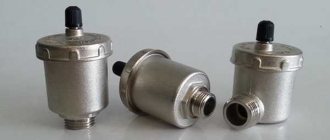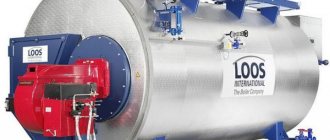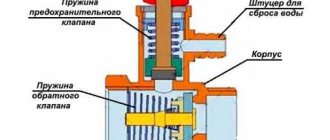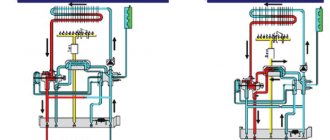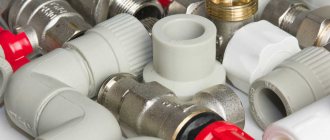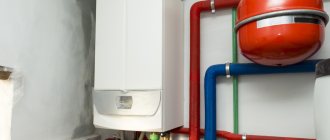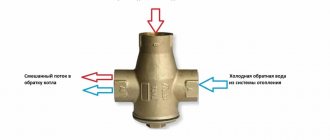Safety valve use
It is not the same as a safety valve. The latter simply relieves pressure in the system, but does not cool it. Another thing is the boiler overheating protection valve, which takes hot water from the system, and instead supplies cold water from the water supply. The device is non-volatile, it is connected to the supply and return mains, water supply network and sewerage system.
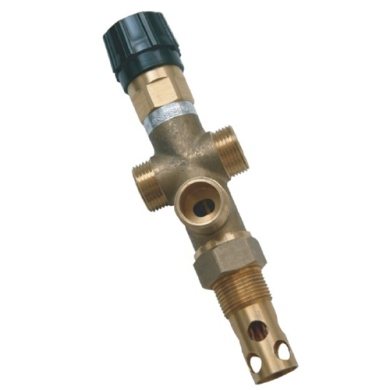
At a coolant temperature above 105 ºС, the valve opens and, due to a pressure in the water supply system of 2-5 bar, hot water is displaced from the jacket of the heat generator and cold pipelines, after which it goes into the sewage system. How the solid fuel boiler protection valve is connected is shown in the diagram:


The disadvantage of this protection method is that it is not suitable for systems filled with antifreeze liquid. In addition, the scheme is not applicable in conditions where there is no centralized water supply, because together with a power outage, the supply of water from a well or a pool will also stop.
Control methods
In addition to the thermostatic head, there are two more options for controlling the device.
- Mechanical. The stroke of the stem is determined by turning the regulator knob.
- Electric. The valve position is controlled by an electric actuator.
The electrical version needs to be dwelt upon in more detail. The thermostatic mixing valve for solid fuel boilers of this type has a rotary design, which is clearly shown in the diagram below.


The principle of operation of this element is simple: an electric drive controlled by the controller turns the locking mechanism to the desired angle. The signal to the controller comes from one or more temperature sensors, which is especially important in multi-circuit CO.
Advice! The main disadvantages of all electrically driven heating devices are volatility and a rather high cost. There is also a simplified version of this device, in which there is no such link as a controller: the mechanism is controlled directly by a thermal sensor. The average cost of budget models with an electric drive is $ 7-10.
What is the danger of condensate for the boiler
When firing up a solid fuel boiler, one has to face the fact that a cold coolant washes the walls of an already heated combustion chamber, cools them, which leads to condensation of water vapor, which is invariably present in the flue gases. Particles of water interacting with flue gases form acids, which leads to the destruction of the inner surface of the combustion chamber and chimney.
But the negative effect of condensate is not limited to this: soot particles that settle on the walls dissolve in water drops. Under the influence of high temperatures, this mixture is sintered, forming a dense and strong crust on the inner surface of the combustion chamber, the presence of which sharply reduces the intensity of heat exchange between the flue gases and the coolant. The boiler efficiency drops.
Removing the crust is not easy, especially if the boiler combustion chamber has a complex heat transfer surface.
It is impossible to completely eliminate the formation of condensate in a solid fuel boiler, but the duration of this process can be significantly reduced.
Design
A typical boiler safety valve has a collapsible design and consists of the following main elements:
Housing. It is usually made of brass and looks like a tee. On its sides there are a lower threaded inlet, a lateral outlet pipe and an upper seat, on which the shaped seal is seated.
Locking group.It is a spring-loaded pulley with a cylindrical (disk) end locking element, on which an elastic rubber seal in the form of a cup (disk) is put on.
Cap. A black heat-resistant polymer cap is screwed into the upper threaded branch pipe of the brass body, which holds the spring-loaded stem in the working position. On the upper edges of the lid there are protrusions along which the top cap shaped in the lower part, connected to the shut-off rod, slides. When turning through a certain angle, the cap rises together with the stem and opens the side branch pipe - this allows the safety valve to be used for heating always open in manual mode.
Cap. The polymer part is usually red in color with a ribbed side surface, screwed to a hollow stem with a screw. The shallow protrusions in the lower part of the cap, when it rotates, fall on the teeth of the cap - the handle rises together with the spring-loaded shutter and opens the side channel, allowing manual pressure relief.
Adjusting washer. The inner wall of the cover has a thread, in which the adjustment nut rotates, when it is lowered down, it compresses the spring - thus increasing the valve response threshold. By unscrewing the nut upwards, the spring is weakened and the response pressure decreases. For turning, the nut is equipped with a transverse slot in the upper part for a flat screwdriver.
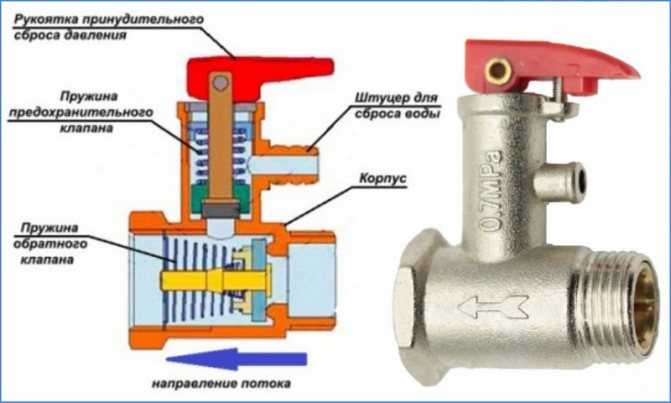

Valve for water heating boilers - design and appearance
Principle of operation and types of valve actuators
The product is produced in different configurations and with different actuators, but the principle of operation of the three-way valve remains the same: mix two streams with different temperatures into one, the temperature of which is set by the user or is required according to the scheme. The liquid inside the valve flows from one branch pipe to another until its temperature changes and reaches the set value. The actuator then gradually opens the flow from the third port, keeping the leaving water temperature within the set value. On this basis, such a valve is called a three-way valve.


Three-way valve working principle
Any 3-way mixing valve has two inlets and one outlet. The distribution of streams is carried out using a drive, which is of several types:
- The thermostatic actuator (thermostat) is one of the most popular, it works due to thermal expansion of the sensing element, as a result of which there is a pressure on the valve stem and the liquid begins to mix.
- A widespread type of actuator, which is installed in a three-way changeover valve, is electric, it operates from a signal from the control unit.
- The valve can be operated by pushing the stem down with the thermostatic head actuator. It reacts to the air temperature, which is determined by itself or with the help of an external sensor and a capillary tube. The drive is most commonly used in underfloor heating systems.


Stationary solid fuel boilers cannot be directly connected to the heating system. One of the reasons is that cold water must not be allowed to enter the boiler jacket until it has warmed up. Otherwise, condensate is released on the walls of the furnace, which, mixing with the ash, forms a strong layer of carbon. It prevents free heat exchange, reducing the efficiency of the installation, and it is very difficult to remove carbon deposits. The second reason is that you need to protect cast-iron furnaces from temperature drops in case of an unexpected shutdown of the pump due to a power outage, and then start it up. The task is not to let cold water into the hot boiler, for which a three-way valve is needed.It will make the coolant circulate in a small circle until it heats up, and only then will it mix in cold water.
Primary heat exchanger


gas boiler heat exchanger
It is a defining element in the operation of the boiler, it serves to transfer heat from the fire of the heating fluid further to the heating system. The design of such a heat exchanger is usually the same for all types of boilers from all manufacturers. Outwardly, it is a copper pipe, inside which heating fluid flows. Such heat exchangers are called "copper". Since the heat exchanger is located above the burner flame, the heat from the fire heats up the copper tube, which transfers the heat to the heating fluid. It is noteworthy that it was copper that was chosen as the metal that successfully copes with the task of retaining heat and, if necessary, its rather rapid loss, since has a high heat transfer coefficient. Also, copper does not rust quickly, due to which the term of its functionality is quite high. In addition to the copper pipe, the heat exchanger is equipped with special plates that help smoothly distribute all the heat from the fire, thereby contributing to uniform heating of the heat exchanger.
How to choose the right one
Before proceeding with the direct purchase of a valve, you should find out a lot of points regarding the boiler used and the features of the heating system, this will increase the efficiency of the system, otherwise it can lead to a deterioration in standard performance.
The main thing in this matter is to determine the operating parameters of the coolant (this is easy to find out using the available documentation). In addition, it is necessary to take into account the heating consumption and the piping scheme itself.
You can determine the flow rate and temperature of the coolant using the design documentation. If there is none, you can use the recommendations that are indicated in the passport of the boiler itself, which is used in the system.
All these parameters are needed in order to choose the right valve (you have to choose purely in terms of throughput).
The drive control system is selected according to the type of heating system and the piping of the boiler itself. The simplest models and options involve the use of a conventional thermostatic valve (although there are exceptions). And, as already mentioned, to ensure high-quality operation of floor heating, you should use a product with a thermostatic head.


If you plan to work with a complex piping system, then manufacturers recommend using a valve with an external control controller.
Be that as it may, any modern heating system must use a three-way valve, which is an important component in the entire system and there is simply nothing to replace it with - no alternative has been invented.
An exception can be called previously used elevator systems, which have not been used for a long time and are considered obsolete (due to their low efficiency and convenience).
Be sure to take into account that there is not only a mixing valve, but also a separation valve. The first option considered above implies the possibility of mixing two streams into one, and the second option, a separating valve, offers the ability to divide one stream into two, while regulating the flow to each of the outlets.
Both of these types of valves can be used in the system. However, a mixing valve is necessary in any case, and a separating one is rarely used in simple heating systems.
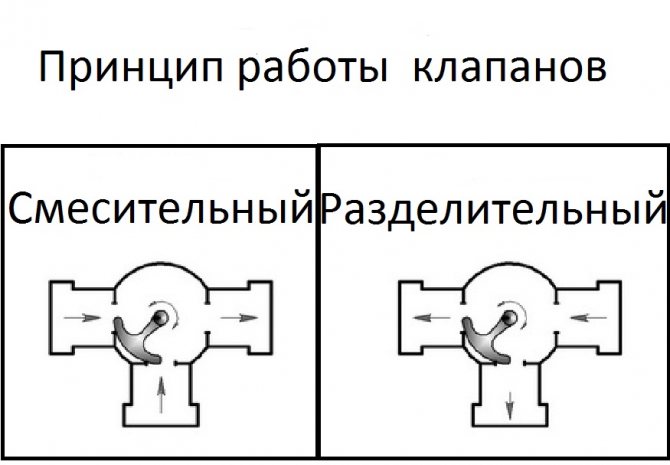

The correct choice of the valve can be called if the user chooses to purchase not only in terms of throughput, but also in terms of temperature.If the first selection criterion is the main one - without taking it into account, one cannot count on the functionality of the system as a whole, then the second criterion implies the duration of the valve's operation - if it is not designed to function in a system where the temperature is higher than the allowable temperature of the valve itself - the part will wear out faster and will require replacement, or will not function at all.
An autonomous heating system is a much more complex mechanism, consisting of a large number of interconnected components and assemblies that perform the corresponding functions. The three-way valve for the boiler in this mechanism plays the role of a mixer, in which the temperature of the coolant is regulated.
This is done so that the pipes are evenly heated and the heating level in each room is approximately the same. If you do not use the part, it will turn out that the water, when passing through the heat exchanger, will not heat up equally, and as a result, some of the rooms will receive less heat energy than all other rooms.
Why do you need a thermostat for a gas heating boiler?
Any heating system is a closed loop filled with water or antifreeze. The boiler heats the coolant, the circulation pump pumps it through the system of pipes and radiators, the heating radiators transfer heat to the end consumer - heating the air in the room. In an ideally balanced system, the boiler must operate continuously with maximum efficiency so that the amount of heat generated by the heating system is no more or less than is required at a particular moment in time.
This requires:
- regulate the temperature of the heating medium
- receive data on the current temperature in the heated room
The coolant temperature is regulated depending on the outside temperature. Typically, this device is called an outside temperature sensor. That is, with the sensor connected, the boiler will independently select the desired coolant temperature. This is very convenient because sometimes the outside temperature can change over wide ranges in short periods of time. Basically, these changes take place at night and the owner of a gas boiler, not equipped with such automation, is forced to constantly run and “tweak” these settings. A particular inconvenience arises when the boiler is located in a separate boiler room or basement.
It remains to find out what is the current temperature in the room for making a decision to turn on the boiler and constantly monitor further changes in this temperature in order to turn off the boiler when the desired value is reached. This is what is needed thermostat for gas heating boiler!
It gives a signal to start and stop the boiler depending on the set temperature in the room.
A room thermostat and an outside temperature sensor are different devices with different purposes, but they are an integral part of the same system.
It must also be understood that the best result can be achieved only if the heating system is initially correctly designed and the premises are properly insulated. After all, if the house has low energy efficiency, frequent switching on of the gas boiler cannot be avoided and the system will have strong inertia.
Frequent starts of the gas boiler inevitably lead to a decrease in the resource of the actuators: fan, pump, electronic control board. Some relays used on the board have a passport stock of 100 thousand cycles. If, for example, the boiler turns on every ten minutes, then the passport number of cycles will be reached in about 3 years.
So, we figured out that thermostat
is necessary to control the on and off of a gas boiler - further we will consider the principle of its operation.
Reasons that may result in overheating of a solid fuel boiler
Even at the stage of selection and purchase, it is important to take into account the operational characteristics of the heating device. Many models that are on sale today have a built-in overheating protection system
Whether it works or not is the second question. However, it is necessary to adhere to certain knowledge and skills, hoping to create an efficient and safe autonomous heating system at home.
The reliable operation of the heating unit depends on the operating conditions. In case of obvious violations of the technological parameters of heating equipment and abuse of standard safety rules, there is a high probability of an emergency.


Possible negative consequences can be prevented even at the stage of installing a solid fuel boiler. Correct piping of the heating device will guarantee your safety and reliable operation of the unit in the future.
In detail, in each case, the solid fuel boiler protection system has its own specifics and features. Each heating system has its own pros and cons. For instance:
When it comes to solid fuel boilers with natural circulation of the coolant, it is necessary to take care of the safety and operability of the heating equipment even during installation. The pipes in the system are installed metal. Moreover, the diameter of such pipes must exceed the diameter of the pipes used for laying a circuit with forced circulation of the coolant. Sensors installed on the water circuit will signal a possible overheating of the coolant. The safety valve and expansion vessel act as a compensator, reducing overpressure in the system.
A significant disadvantage of the gravitational heating system is the lack of an effective mechanism for adjusting the operating modes of solid fuel boilers.
Large technological opportunities for consumers are provided by those working with forced circulation of the coolant in the system. Already only the presence of the second circuit significantly increases the ability to regulate the heating temperature of the boiler water. The only drawback in the operation of such a system is a working pump, which can make it difficult to operate the heating system with its work.
This is due to the fact that when the electricity is cut off, the pump stops performing its functions. The stoppage of the circulation process and the inertia of solid fuel heating boilers can lead to overheating of the heating unit. If the boiler equipment is not equipped, the situation with a power outage is fraught with extremely unpleasant consequences.
Effective protection against overheating of a working solid fuel boiler should be based on the mechanism for removing excess heat generated by the heating device.
Criterias of choice
The overall operation of the heat supply system will depend on the correct choice of a three-way mixing valve for a solid fuel boiler.
An important indicator of the choice is the flow rate of the coolant or the throughput of the TC, that is, the volume of water that the valve can pass in an hour.
In addition, before buying a 3-way device, get acquainted with the following characteristics:
- Connection diameter to the system. For solid fuel units, it is in the range of 20-40 mm.
- Option to turn on the servo drive, for automatic regulation.
- Product material. Preferred copper or cast iron versions.
- The temperature range of the product is usually 90 C.
Bandwidth estimation
The flow rate of the coolant will need to be known then in order to select a product for its throughput.Typically, such data is in the passport for the heating system, boiler, or they can be set according to the performance of the circulation pump.
If there is no such data, the calculation is performed according to the formula:
P = 3600M / s (dT), where:
- P is the hourly flow rate of the coolant, kg / h;
- M is the power of the heat supply system, kJ;
- c - specific heat capacity of the water heat carrier, 4.187 kJ / (kgC);
- dТ - temperature difference between supply and return.
Having calculated the consumption indicator, they compare it with the passport throughput of the product.
The need for placement
The three-way valve and its actuator must be compatible with the heating circuit. It is easier to install a thermostatic version such as a Hertz separating valve.
In it, the coolant circulates from the 3rd branch pipe to the first, the boiler unit heats the water along a small circulation loop to the required temperature, the tap opens the flow from the second branch pipe for mixing hot and cold water, after which the coolant of the required temperature enters the heating system.
What are the ways to protect heating equipment from overheating
Manufacturing companies are trying to increase the consumer attractiveness of their products, to include in the technical passport of boiler equipment any guarantees of its safety. The uninitiated consumer does not have the slightest idea about the means of protecting the heating boiler from boiling.
There are currently the following ways to ensure the protection of solid fuel units used for autonomous heating systems. The effectiveness of each method is explained by the operating conditions of the boiler equipment, and the design features of the units.
In most cases, manufacturers recommend using tap water for cooling in the data sheet for a heater. In some cases, solid fuel boilers are equipped with built-in additional heat exchangers. There are models of boilers with external heat exchangers. Used by a safety valve to prevent overheating. The safety valve is designed only to relieve excessive pressure in the system, while the safety valve opens access to tap water when the boiler overheats.
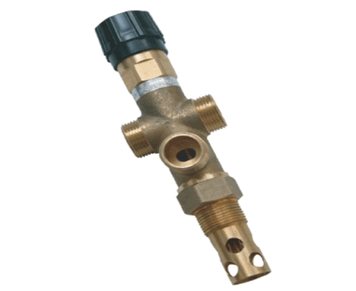

If the temperature of the coolant exceeds the 100 ° C mark, it creates an excess pressure that opens the valve. Under the influence of tap water, which is supplied under a pressure of 2-5 bar, hot water is displaced from the circuit by cold water.


The first controversial aspect of tap water cooling is the lack of electricity to power the pump. The expansion vessel does not have enough water to cool the boiler.
The second aspect, which sweeps aside this cooling method, is associated with the use of antifreeze as a heat carrier. In the event of an emergency situation, up to 150 liters of antifreeze will go into the sewer along with the incoming cold water. Is this protection method worth it?
The presence of a UPS will allow maintaining the operation of the circulating pump in a critical situation, with the help of which the coolant will evenly disperse through the pipeline, without having time to overheat. As long as there is enough battery capacity, an uninterruptible power supply ensures that the pump is running. During this time, the boiler should not have time to heat up to the critical parameters, the automation will work, starting the water along the spare, emergency circuit.
Another way out of a critical situation will be to install an emergency circuit in the piping of a solid fuel unit. Shutdown of the pump can be duplicated by the operation of the reserve circuit with natural circulation of the coolant. The role of the emergency circuit is not in providing heating of living quarters, but only in the ability to remove excess heat energy in an emergency.
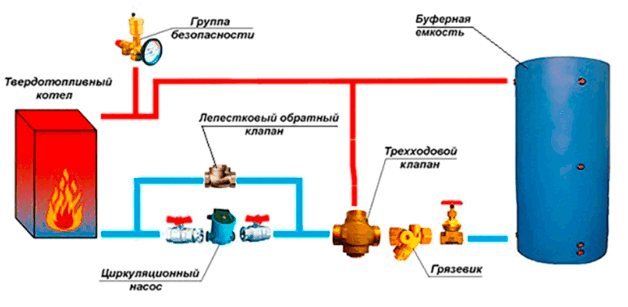

Such a scheme for organizing the protection of the heating unit from overheating is reliable, simple and convenient in operation. You will not need special funds for its equipment and installation. The only conditions for such protection to work are:
- the presence of an expansion tank or storage tank in the system;
- use of a check valve only of the petal type;
- the pipes in the secondary circuit must be of a larger diameter than the conventional heating circuit.
The main task that the safety valve solves
The device is an autonomous device, completely independent from external power supply sources. If most of the automatic control devices are powered from the mains, then in this case an inconspicuous device plays the role of the last protective barrier for solid fuel boilers from overheating. The simplest device is designed to respond to changes in the temperature regime of the boiler water circulating through the heating circuit. If the temperature of the coolant has reached a critical level (95 degrees or more), a safety valve is activated, which opens access to the superheated circuit of cold water.
On a note: In this case, we are talking about a way to protect the boiler from overheating by mixing in cold water.
The device that you have high hopes for should meet the following requirements:
- high throughput;
- high sensitivity of the thermostatic element inside the structure;
- compliance with the control measurements declared by the manufacturer.
We have already said that the main function that is assigned to this device is to protect heating equipment from overheating. Hence follows the basic principle of the mechanism. By mixing cold and hot water in the heating circuit, the overall temperature not only of the heating medium in the system is reduced, but also in the heating device. Consequently, the mechanism is installed on the main pipeline, creating three different directions for the movement of the boiler water.
How to install
When installing the safety drain fittings, observe the following rules:
- Typically, the pressure relief valve in the heating system is installed in the household circuit in a single copy. Its main points of placement are directly above an electric, solid fuel, gas boiler at its outlet or next to a horizontally located pipeline. If this is not possible for technical reasons, the main condition for correct installation is installation in the supply line up to the first shut-off valve.
- The outlet side pipe is usually connected to a sewer or drainage system, if it is technically difficult or the volume of the coolant in the circuit is not high, you can use a flexible hose, which is lowered into a container of a suitable volume.
- The liquid must be removed with a rupture of the jet through a funnel or a hydraulic seal to ensure the system is operational when the sewer is clogged.
- For installation in a pipeline, use a BOTTOM tee of a suitable diameter, the standard being 1/2, 3/4, 1 and 2 inches. The diameter of the pipeline inlet to the valve must not be less than that of the system.
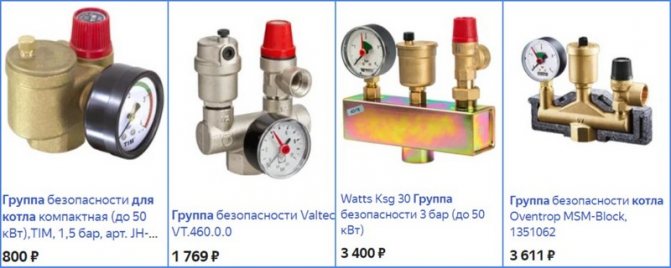

Valve safety groups - varieties and price
Basic structure of a gas boiler
The external device of such a gas boiler includes:
A body that protects the boiler itself from fire and from outside interference for its high-quality operation
- The control panel for entering certain commands that regulate the temperature in the heating, respectively, and the temperature of heating the water. By design, the control panel can consist of either rotary knobs or touch buttons
- A display that clearly displays the temperature that we set using the control panel, at what stage the heating is currently, possible errors and malfunctions in the system, with which it is possible to determine which problems have occurred with the boiler
- Manometer (mechanical or electronic), with which we can see the pressure of fluids in the heating system.
It should be noted that modern boilers work only in closed systems with the creation of a water pressure in this system from 1 to 2 atm.
The internal structure of a gas boiler includes:
- Primary heat exchanger
- Gas-burner
- Pump
- Gas fittings
- Secondary heat exchanger
- Three-way valve
- Turbine (smoke exhauster)


Consider working principle of a gas boiler, examining in detail each element of the internal structure:
Valve types
So, in more detail about the two existing types of valves, you can read below:
- 1. The three-way thermostatic valve for the boiler is an automatic model. It will maintain the set temperature level without additional human intervention. At the same time, the most functional models are equipped with an additional security system that blocks the movement of the coolant if there is no circulation through one of the incoming pipes. Thus, boiling will not occur in the batteries.
- 2. The three-way thermo-mixing valve for the boiler can be completed with both automatic and manual control. The fundamental difference will be the need to regularly check the state of the system so that it does not overheat. To date, mechanical devices have already practically been abandoned, since they have been replaced by more advanced units.
How to choose a thermostatic mixing valve
The thermostatic mixing valve for solid fuel boilers should be selected according to parameters that are relevant both to the control valves and to the characteristics of a particular heating boiler:
- By material of manufacture. This is an extremely important selection criterion that affects the technical and operational characteristics of the device. A copper or cast iron valve is considered the best.
- By the volume of consumption of the coolant. This indicator can be found from the data sheet for the boiler or from the design documentation for the heating system. The flow rate of the coolant must be known in order to correlate it with the flow capacity of the valve.
- A three-way thermostatic valve for a solid fuel boiler is selected based on the modification of the drive and the piping scheme. In a simplified version, the scheme is as follows: the valve supplies the coolant from the third branch pipe to the first one. As soon as the liquid in the boiler heats up to the required temperature, a stream of unheated coolant will come out of the second branch pipe. In fact, an exchange will take place when the cold liquid from the heat accumulator tank is replaced by a hot one. If there is a controller on the crane, then the strapping is more complicated. Here you will need a two-circuit and two-drive mixers. The first (thermostatic) is placed next to the heat source. The second drive is electric and is controlled by a controller that sends signals from the sensor. The thermostatic valve for solid fuel boilers maintains the set water temperature.
Important. The choice of the actuator is an extremely important component when purchasing a thermo-mixing valve for a solid fuel boiler. Manual ones are much cheaper, more reliable, but less functional, electric ones break down faster and are much more expensive, but they solve the problem radically. - The most important operating parameter of a three-way mixing valve for a solid fuel boiler is the maximum permissible temperature of the coolant. It should be between 35 and 60 degrees.When it comes to valves for hot water supply or floors with water heating, the requirements for devices with a thermostatic drive are different, since the temperature reaches 90 degrees.
- When purchasing a valve, you need to take into account the dimensions of the inner and outer diameters for connecting to the heating system. In the event that you cannot find the desired size, you can use a conventional adapter to solve the problem.
Varieties
The existing types of valves are capable of working with boiler equipment from leading foreign (Vaillant, Baxi, Ariston, Navien, Viessmann) and domestic (Nevalux) manufacturers on gas, liquid and solid fuels in situations where automatic control over the operation of the system is difficult due to the type of fuel. or broken when the automation fails. Depending on the design and the principle of operation, safety valves are divided into the following groups:
- According to the purpose of the equipment in which they are installed:
- For heating boilers, they have the above design, they are often supplied on fittings in the form of a tee, in which a pressure gauge for checking the pressure and a vent valve are additionally installed.
- For hot water boilers, there is a flag in the design for draining water.
- Containers and pressure vessels.
- Pressure pipelines.
- According to the principle of actuation of the pressure mechanism:
- From a spring, the clamping force of which is regulated by an external or internal nut (its work is discussed above).
- Lever-cargo, used in industrial heating systems designed to discharge large volumes of water, their response threshold can be adjusted with suspended weights. They are suspended from a handle connected to the shut-off valve by the principle of a lever.


Lever-load modification device
- Locking mechanism response speeds:
- Proportional (low-lift spring) - the sealed lock rises in proportion to the pressure and is linearly related to its increase, while the drain hole gradually opens and closes in the same way with a decrease in the volume of the coolant. The advantage of the design is the absence of water hammer at various modes of movement of the shut-off valve.
- Two-position (full-lift lever-cargo) - operate in open-closed positions. When the pressure exceeds the response threshold, the outlet opens completely and the excess volume of the coolant is vented. After the pressure in the system is normalized, the outlet is completely closed, the main design flaw is the presence of water hammer.
- By adjustment:
- Non-adjustable (with caps of different colors).
- Adjustable with screw parts.
- According to the design of the adjusting elements of the compression of the spring with:
- An internal washer, the principle of operation of which was discussed above.
- Outside screw, nut, models are used in household and communal heating systems with large volumes of coolant.
- With a handle, a similar control system is used in flanged industrial valves, when the handle is fully raised, a one-time drain of water can be performed.
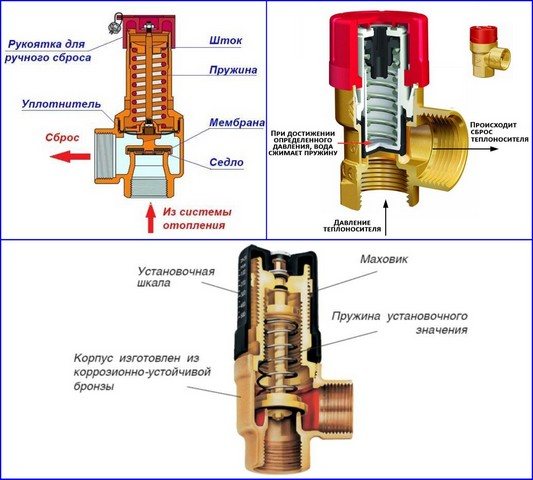

Designs of various models of drain valves
Kau triple thermostatic valve
There are two types of thermostatic valves:
- mixing
- flow A entering the valve is divided into flow B and flow AB - distributive
- stream A entering the valve is divided into 2 streams
The mixing valve is installed in the return pipe and the control valve is installed in the supply pipe. The valve is controlled by a thermal head with a thermal bulb.
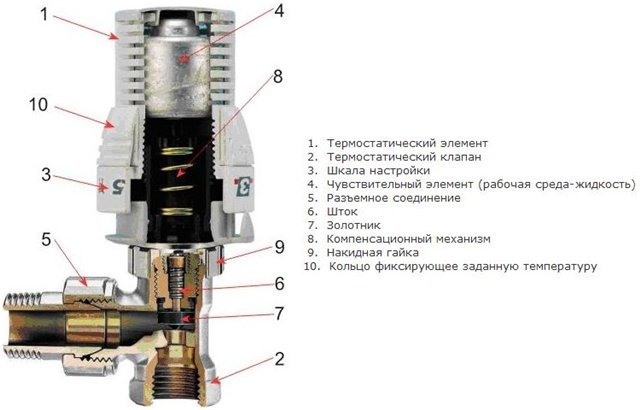

The thermo bulb with the help of a special sleeve is attached to the surface of the return pipe in close proximity to the heating boiler.Inside the flask there is a working fluid, the temperature of which is equal to the temperature of the coolant before entering the boiler. If the temperature of the coolant rises, the working fluid increases in volume, and, conversely, when the temperature of the coolant decreases, the volume of the working fluid decreases. Expanding or contracting, the working fluid presses on the stem, closing or opening the thermostatic valve.
With the help of the thermal head, you can set a certain temperature, above (below) which the heating medium will not be heated. How to set the temperature by choosing the operating modes of the thermal head is described in detail in the instructions for it.
Another feature of the thermostatic valve is that it reduces the flow of the coolant to the boiler, but never blocks it or opens it completely, protecting the boiler from overheating and boiling. The valve is fully closed only at the moment of starting the boiler.
Thermal mixing valve design and operating principle
Like most parts and structural elements of a solid fuel boiler, a three-way or also has a simple and understandable design. It includes:
- main building;
- spring loaded stem;
- two dampers, disc type;
- thermostatic element (head with fixed positions).
The diagram shows the mechanism in detail in a section, where and how its main elements are located.
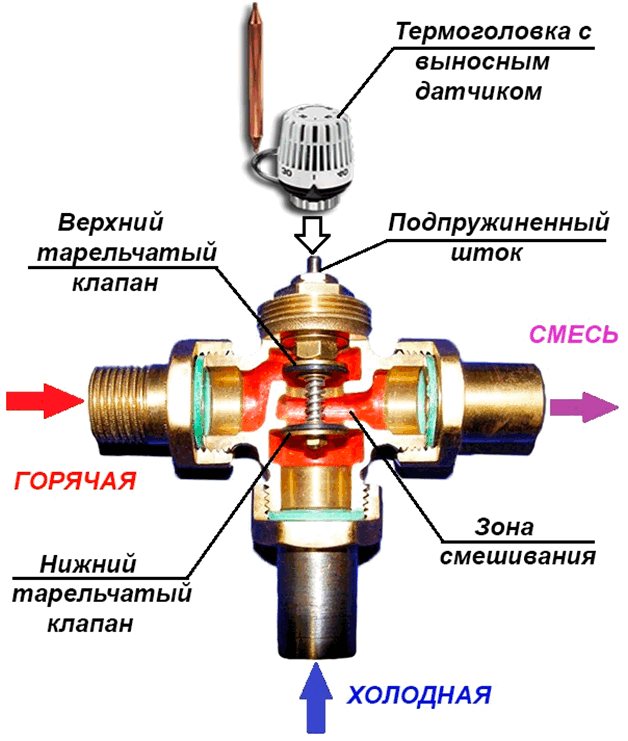

Looking at the design of the device it is not hard to understand the principle of operation. Let's consider in more detail the ongoing processes.
In the normal operating mode of the heating system, the main dampers located linearly are in the open position. Insufficiently hot water flows freely from the boiler into the heating circuit.
The thermostatic head, equipped with a temperature-sensitive liquid sensor, is in the standard position. In the event of an emergency situation, for example: from the side of the boiler, a coolant begins to flow into the system, the temperature of which exceeds the specified parameters. The temperature control sensor is triggered, driving the stem. The operating mechanism closes the main, direct-flow passage, simultaneously opening the passage from the side, through which cold water enters. As a result of mixing water of different temperatures, the temperature is equalized to the set rate. The coolant, already at normal temperature, leaves the device through a pipe to the heating system. The adjustment of the thermostatic head of the device is determined by the degree to which the bellows with the expanding liquid is pressed on the stem. Determines the sensitivity of the device accordingly.
The moment the device is triggered is determined by adjusting the head set to a certain temperature.
If the water continues to heat up as a result of the actions taken, the device shuts off the main inlet flow, opening the access of cold water from the third pipe. The stem in this case is in the lowest position. Water from the third branch pipe is already mixed into the main stream. When the temperature of the coolant changes downward, the stem, under the action of the sensor, reduces the pressure, opening access to hot water.
In order to achieve the correct operation of the entire mechanism, it is necessary to precisely comply with the requirements for its installation. It can be installed in a right-hand or left-hand version, both on the return and on the supply circuit. During operation, the device does not require maintenance at all.
Device
The main plus of any domestic gas equipment is affordable prices, in addition, it is easy to find spare parts for it. Russian boilers outperform imported ones in terms of adaptation to local conditions. Many European heaters cannot withstand the harsh climatic conditions and peculiarities of gas and water supply in Russia.
Boilers "Termotekhnik" have a standard device typical for classic atmospheric and turbocharged devices. They do not have any special features: gas is supplied to the burner, which, when burned, gives heat energy to the heat exchanger. The latter heats the coolant, which, continuously circulating, carries heat through the heating system.
Computerized automation controls all processes: it takes readings from sensors and, based on the information received, adjusts the operation of the system.


Main characteristics
The parameters of gas heaters are inferior to European counterparts, but for internal consumption their characteristics are excellent:
- run on natural gas or propane-butane;
- nominal water pressure - 0.85 MPa;
- thermal insulation 10 cm thick;
- the minimum temperature of the heating agent in operating mode is 60 ° C. If it is lower, then the heater is faulty.
How to choose
It is not easy to understand the wide range of boilers presented. The primary factors that the consumer must take into account are the climatic conditions of the area and the heated area. When choosing a suitable option, you must first of all pay attention to:
- thermal power;
- Efficiency;
- gas consumption;
- cost and dimensions.
Also, the consumer needs to decide:
- with the type of installation - floor or parapet;
- with the number of contours - one or two. Double-circuit versions not only heat homes, but also heat water for domestic use.
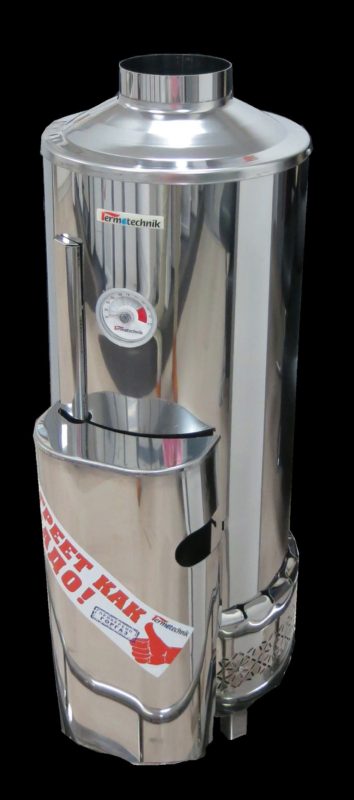

Why the valve can leak
The pressure relief valve in the heating system can leak for various reasons. In some situations, this is an acceptable natural process, in other cases, a leak indicates a malfunction of the device.
Leakage of the protection valve can be caused by the following reasons:
- Damage to the sealed rubber cup, disc as a result of repeated use. If, during repair, the replacement part cannot be found on sale or it is not included in the package, you will have to change the device completely.
- In spring types, the opening of the side drain pipe occurs gradually, with boundary pressure values or short-term surges, the valve may partially work and drip, which does not indicate a malfunction.
- Leakage can be caused by incorrect settings or malfunctions of the expansion tank - damage to its membrane, air escaping through a depressurized housing or a damaged nipple. In this case, sudden pressure surges are possible as a result of water hammer, causing a periodic short-term flow of the coolant through the safety valve.
- Some adjustable valves are leaking because fluid seeps down the stem from the top during actuation.
- If a back pressure is created at the branch pipe above the instrument response threshold, a leak also occurs.


Appearance, cost of some brands of drain valves
The safety valve of steam boilers is designed to protect them from overpressure in the system caused by various factors, and is an indispensable element in the operation of this type of equipment. A wide range of safety devices from Chinese, domestic and European manufacturers are available for sale at a relatively low cost. When buying, it is rational to choose a protective group from several devices, which additionally include a pressure gauge and an air bleed valve.
Water dripping from the safety valve. What to do
Accumulative water heaters today are in great demand among our compatriots. These units simply allow them to effectively solve many economic problems, but sometimes it happens that the device itself becomes the source of the problem.
One of the most common problems that one has to face is water leakage.If water drips from the safety valve, then, as soon as possible, it is necessary to establish the cause, because in some cases this process should not be considered a malfunction. That is why there is no need to rush to the decision to call a water heater repair specialist.
Possible causes of the malfunction
The reasons for water leakage from the valve can be:
- Valve malfunction;
- Incorrectly set pressure difference in the system;
- Other reasons, in particular, water may flow out of the valve, but this will not be considered a failure.
The first two reasons involve the repair of the unit.
Troubleshooting methods
Gas water heaters should be tested first. It is necessary to determine in what situation the outflow of water occurs.
If you noticed that water flows out during the heating of water, then, most likely, your unit is completely operational. The fact is that when heated, the water expands, respectively, the pressure of the liquid on the walls of the tank increases
When the pressure exceeds the norm, the valve gets rid of excess water. The solution to this problem can be the connection of a rubber hose and its output to the sewer or a container of the required size.
If the safety valve of the water heater passes cold water, then most likely the reason is that the pressure in the water supply is too high. The solution to this problem is to install a reducer to normalize the pressure in the water supply network. To do this, you must contact a qualified specialist. Also, you cannot do without the help of a professional if you are inclined to conclude that the cause of the water leak is a malfunction of the valve itself.
Thus, the first step to solving problems with water leakage from a water heater is to establish the cause of the leakage and establish the nature of the malfunction. Remember that it is always safer to turn to a professional for help than to repair complex equipment on your own, because inept repairs can lead to a more complex malfunction.
Nominal diameter and adjustment
The flow area of the safety valve must be equal to or greater than the cross-section of the pipe on which it is installed. Otherwise, the hydraulic resistance of the device will be too high, as a result of which the operation of the system will be disrupted.
The adjustment of the heating system safety valve depends on the type of pressure mechanism. In spring devices there is a cap, the rotation of which sets the pre-compression of the spring. These products are characterized by a high control accuracy of +/- 0.2 atm.
Lever weight valves are less accurate. To do this, you need to move the weight along the lever or increase its weight.
Fig. 3. Independent connection diagram of ITP with pressure maintaining device
Such a scheme is somewhat more expensive than a dependent one, but at the same time it protects indoor heating devices from low-quality coolant coming from the central network. If, in addition to heating, it is necessary to provide centralized hot water supply, then one or more heat exchangers are additionally installed. Depending on the ratio of the heating load and hot water supply, one-stage and two-stage schemes for connecting water heaters are used.
Examples and ROI
In Ukraine, modern automated heating units with an independent connection scheme are offered by the Austrian company Herz.
IHPs from Herz operate at a supply water temperature in the primary circuit (district heating) of 110–140 ° C / 65–80 ° C. At the same time, the temperature in the in-house heating system is maintained at 90–55 ° C / 70–45 ° C. The nominal pressure in the primary circuit is up to 16 bar. The operating pressure in the secondary circuit is from 2 to 10 bar.To maintain the pressure in the system, a diaphragm expansion vessel is used or, in the case of systems with a capacity of more than 300 kW, a pressure maintenance unit. The circulation of the heating medium is carried out by highly efficient frequency-controlled pumps.
In the ITP configuration, schemes are implemented based on a two-way valve or a combination valve - an electric flow regulator, and a plate or brazed heat exchanger. Weather-dependent regulation of the coolant temperature, temperature settings are carried out by the controller. At the same time, it is possible to organize remote access and control of equipment via a GPRS modem. To account for heat consumption, an ultrasonic flow meter with a computer is provided.
Apart from ITPs, apartment heating points are also used for multi-storey buildings. They allow the consumer to individually regulate the operation of the heating system and hot water supply, and provide the convenience of metering the consumed energy. For example, the Herz DeLuxe substation is designed for a maximum operating temperature of 90 ° C, a maximum operating pressure of 10 bar and provides a hot water flow of up to 15 l / min. Such heating points are installed directly for each consumer (apartment). There are options for open or hidden installation in the wall, as well as with a mixing unit for low-temperature radiant panel heating, for example: warm walls, underfloor heating (Fig. 4).
Fig. 4. Compact apartment heating station Herz Bregenz
The payback time for ITP investments for building retrofits ranges from 1 to 5 years and depends on the equipment used, the size of the building and the type of system. It should be remembered that the installation of individual heating points is an important and necessary step, but not the only one on the way to the energy efficiency of the heating system of a residential building. The greatest effect is achieved together with balancing the heating system and installing thermostatic valves on heating devices.
Views count: 5 337
We complete the boiler properly
Solid fuel boiler for hot water heating is a common type of heating element in private houses. The modern equipment market offers customers a number of components that will help increase the efficiency, safety and convenience of a solid fuel boiler. In this case, we are talking about thermostats. They are designed to control the temperature of the coolant in the heating circuit, depending on its value, to influence the intensity of combustion of the energy carrier in the furnace.
Correctly chosen chimney for the boiler is the safety of the house. It must be selected in strict accordance with the instructions for the purchased boiler. For trouble-free operation of the boiler in cases of a power outage or a power surge in the power grid, experts recommend buying an IPB. The video below will help you understand the setting of the draft regulator for a solid fuel boiler:
Basic principle of boiler protection against condensation
To protect the solid fuel boiler from the formation of condensation, it is necessary to exclude a situation in which this process is possible. To do this, you must not allow the cold heat carrier to enter the boiler. The return temperature should be less than the flow temperature by 20 degrees. In this case, the supply temperature must be at least 60 C.
The easiest way is to heat a small amount of coolant in the boiler to the nominal temperature, create a small heating circuit for its movement and gradually mix the rest of the cold coolant with hot water.
The idea is simple, but it can be implemented in various ways. For example, some manufacturers offer to purchase a ready-made mixing unit, the cost of which can be 25 000
and more rubles. For example, the FAR company (Italy) offers similar equipment for
28,500 rubles
and the company
Laddomat
sells a mixing unit for
25,500 rubles
.
A more economical, but at the same time no less effective way to protect a solid fuel boiler from condensate is to regulate the temperature of the coolant entering the boiler using a thermostatic valve with a thermal head.
Operating rules
When operating a three-way valve, it is required to follow the established rules in order to ensure trouble-free operation of the heating system.
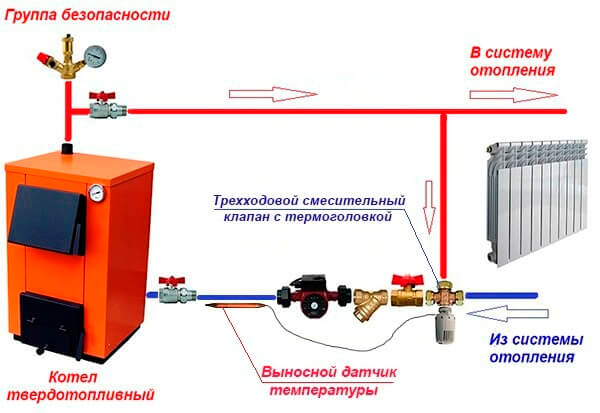

The procedure for operating three-way valves in heating systems of a solid fuel boiler is recommended for Russian thermostatic devices, as well as for the Barberi, Esbe, Icma brands:
- Installation and adjustment of the product is carried out only in accordance with the manufacturer's instructions.
- Inspection of the technical condition is carried out daily with control of the temperature of the coolant.
- Filters are disassembled before each heating season.
- Maintenance of the electric drive is carried out in accordance with the operating rules for the drive.
- The drive housing must be grounded with a 1.5 mm copper wire.
- The sound level generated by the device during operation must not exceed 45 dB.
So, summing up the above, we can state the following: a three-way valve is a variation of shut-off and control valves.
The principle of its functioning is to regulate the flow of the coolant in the heating system. Modern heat supply schemes are required to be equipped with such regulating devices in order to increase the efficiency of work and achieve the required sanitary regime in a residential area.
Principle of operation
The valve protecting the boiler has a simple device and works according to a principle that is understandable even for a schoolchild. The instrument consists of a straight fitting with a 90 degree elbow and a spring-loaded, pressure-tight seal that closes off the side passage. When the pressure in the system increases from overheating, exceeding the clamping force of the spring holding the valve in a stationary position, it rises up and opens the side hole.
Excess liquid begins to pour out from the side and is sent to a container, drainage or sewer system. After venting part of the coolant, the pressure in the system and on the valve weakens, the spring puts it in place, blocking the side pipe.
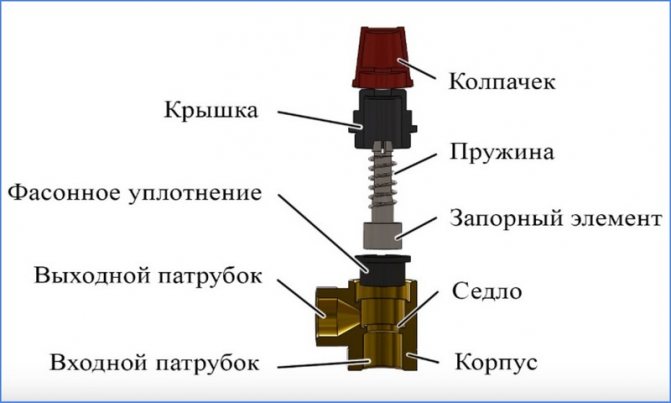

Spring type constructive device

